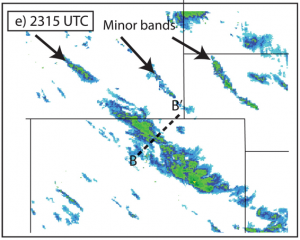Case studies: Do I need multiple cases to make my point?
My colleague Russ Schumacher and I have been discussing a paper that we want to write about banded precipitation along the Front Range of the Rockies. Russ has seen multiple events each winter, and the processes that produce these bands are not well understood, even though we have already written a couple of papers on them.Schumacher, R. S., D. M. Schultz, and J. A. Knox, 2010: Convective snowbands downstream of the Rocky Mountains in an environment with conditional, dry symmetric, and inertial instabilities. Mon. Wea. Rev., 138, 4416-4438. [HTML] [PDF]
Schultz, D. M., and J. A. Knox, 2006: Banded convection caused by frontogenesis in a conditionally, symmetrically, and inertially unstable environment. Mon. Wea. Rev., 135, 2095-2110. [HTML] [PDF]
Because Russ has a collection of these types of bands, the question arose how many different case studies do we need to present to make our point about how these bands form and evolve?
I argued that if we had one good set of simulations of this 16 Feb 2007 event, comprising a control case and some model sensitivity experiments, then we have enough material for a publishable paper. If we had run simulations on a different event and found out that the results were similar to the 16 Feb 2007 event, then we could say in our discussion section that we had performed the same simulations on a different event and came to the same conclusions. Although not definitive, because we got the same answer on two different events showing similar structures and evolutions to the bands, then we should have some faith that our results have some generality beyond a single event.
I tend to view papers that present multiple cases to demonstrate the same point as tedious. As a reader, if I read through the development of a case and got the idea that the author was trying to communicate, then a second case doesn’t drive the point home any more clearly. I am bored.
One big exception to my belief that one complete case is usually enough is if the authors are using two cases to contrast two different evolutions. A nice example of how you might do that is the following paper.
Schultz, D. M., 2004: Cold fronts with and without prefrontal wind shifts in the central United States. Mon. Wea. Rev., 132, 2040-2053. [HTML] [PDF]
In the part of that paper containing the case studies, the focus was on comparing two cases: one cold front with a prefrontal trough and one without. I felt it was an effective way to use multiple cases in the same paper.
Another situation where you might want to include multiple cases is a situation like Schumacher et al. (2010) where we were first calling attention to the existence of these bands. At the end of the paper, we presented a figure with three different cases illustrating that these banded structures occur more than once. In fact, they occur relatively frequently (a few times a year). So, some snapshots of the bands and brief descriptions of these events, comparing and contrasting them, help add some weight to our arguments that these are features worthy of study without adding the weight of much additional and unnecessary text.
To summarize, if a case study is clearly presented to illustrate a point that you as an author want to make, then I believe this is an effective means for using case studies.
For more on effective case studies in meteorology, read:
Schultz, D. M., 2010: How to research and write effective case studies in meteorology. Electronic J. Severe Storms Meteor., 5 (2), 1-18. [EJSSM]



